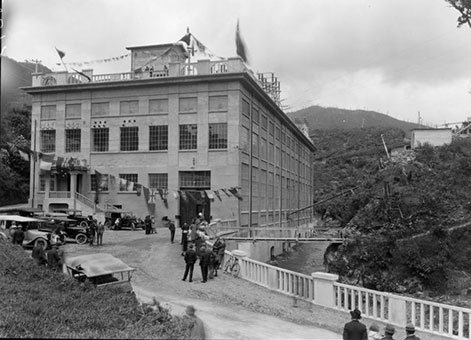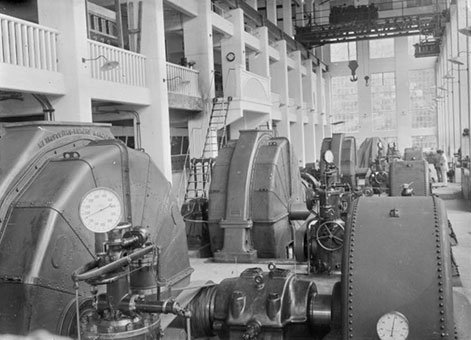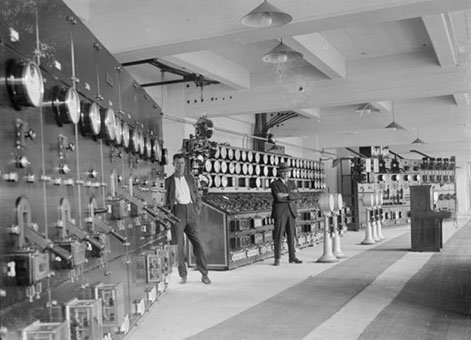The Mangahao Power Station was the first of many large hydro power stations to be built in New Zealand under a government-resourced plan to provide a national supply of electricity.
An essential part of the national supply concept was the provision of a countrywide electrical power transmission system, and Mangahao was to become the point of supply not only for Wellington, but also Horowhenua, Taranaki, Hawkes Bay and the Wairarapa. The 110 kilovolt (KV) transmission lines from Mangahao to these areas were to prove to be the forerunner of New Zealand’s extensive transmission grid.
Whereas most New Zealand hydro stations are built on rivers or supplied by natural lakes, Mangahao makes use of small and remote rivers in the bush-clad Tararua Ranges. The Mangahao River which flowed eastward into the Wairarapa was dammed and its flow diverted via a tunnel into a reservoir formed by a dam on the westward flowing Tokomaru Stream. From there via another tunnel the flow passed into a surge chamber and down a hill in dual penstocks to the power station located on the Mangore Stream; the tunnels and pipelines totalling 4.8 kilometres. Water storage in the two reservoirs was an essential part of the scheme, necessitated by the variability of the Mangahao river flow.
The station had a head of 275 metres. Pelton wheel water turbines drove three 4.8 megawatt (MW) and two 2.4 MW generators giving an output of 19.2 MW.

Mangahao power station, 1924. Crown Studios Ltd: Negatives and prints. Ref: 1/1-032602-F. Alexander Turnbull Library, Wellington, New Zealand.
The possibility of this scheme was covered in the report of Peter Seton Hay in 1904 on the country’s hydro-electric resources, but the final concept was that of Frederick Kissell who became the Chief Electrical Engineer of the Public Works Department and later (in 1946) General Manager of the State Hydro-Electric Department.
Detailed survey work led by C Sealy was started in 1915 to establish river flows, levels and dam sites. This work, and later surveys for road access by George Anderson, had to be done in rain-soaked, steep and densely wooded terrain. The contribution of the early surveyors has never been fully recognised. Anderson was also involved on the construction project.
War delayed the start of construction, but by late 1919 access roading and foundation testing was well in hand. Slow and difficult access made it necessary for camps to be set up close to the construction sites at Arapeti (No.3 dam and tunnel) and Mangahao No.2 dam. No.2 tunnel construction claimed eight lives – seven by carbon monoxide in one incident. This project was led by William Hudson, who was later to oversee the construction of the Snowy mountains scheme in Australia.
The powerhouse is located on the Mangore Stream which discharges into the Manawatu River.

Mangahao Power Station, 1924. Ref: APG-1740-1/2-G. Alexander Turnbull Library, Wellington, New Zealand.
The station was opened in November 1924, with first supply going to the local Horowhenua area. Coverage was soon extended 100 km to Wellington by duplicate 110KV lines, followed by similar lines to Bunnythorpe near Palmerston North for supply to the Manawatu. These lines were the first lines at this high voltage in the Southern hemisphere, and followed US practice.
Recently the two smaller generating sets were replaced by a 26 MW Francis turbine unit and, with upgrades, the station capacity is now 38 MW.
Mangahao Power Station was originally owned by the government but is now jointly owned and operated by Todd Energy and King Country Energy.

Mangahao Power Station, 1924. Ref: APG-1739-1/2-G. Alexander Turnbull Library, Wellington, New Zealand.
Heritage recognition
This place has been recognised by Heritage New Zealand as a Category 2 historic place (List no. 4066):
Mangahao Hydro Electric Power Station: New Zealand Heritage List/Rarangi Korero information.
More information
Access
The exterior of the power station can be viewed from Mangahao Road, east of Shannon.
References
John E Martin; People, Politics and Power Stations, ECNZ. 1990.
Shannon News. Special Edition, 3 November 1924.
Souvenir Descriptive Pamphlet-Mangahao Hydro-Electric Development, Official Opening 3 Nov 1924.
Additional image gallery details
Mangahao Power Station, 1924. Crown Studios Ltd: Negatives and prints. Ref: 1/1-032602-F. Alexander Turnbull Library, Wellington, New Zealand.
Mangahao Power Station, 1924. Ref: APG-1740-1/2-G. Alexander Turnbull Library, Wellington, New Zealand.
Mangahao Power Station, 1924. Ref: APG-1739-1/2-G. Alexander Turnbull Library, Wellington, New Zealand.
Permission of the Alexander Turnbull Library, Wellington, New Zealand, must be obtained before any re-use of these images.
Location
Mangahao, Horowhenua.
